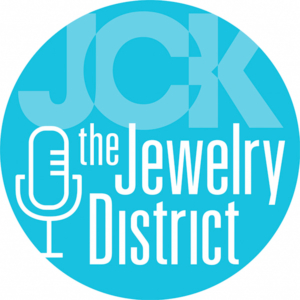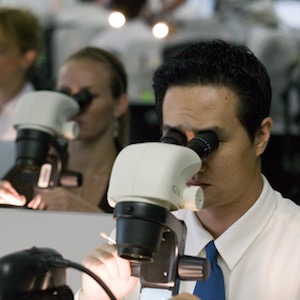
You’ll hear JCK editor-in-chief Victoria Gomelsky and news director Rob Bates talk about what was hot at the Tucson gem shows and the insights Victoria gleaned as she followed several designers on their searches through the shows. Rob discusses some diamond supply news, including the ongoing negotiations between De Beers and Botswana, and the possibility of changes to sanctions on Russian diamonds. The podcast episode also covers ChatGPT, which people in the jewelry industry—including Rob—have started to experiment with.
Listen Now
Show Notes
02:25 Thoughts on Tucson gem shows
12:35 Diamond market news
20:40 Testing out ChatGPT
Episode Credits
Hosts: Rob Bates and Victoria Gomelsky
Producer and engineer: Natalie Chomet
Show Recap
Gem shows shine through cloudy economy
Victoria notes that those shows depend so much on how the fourth quarter went for retailers: if the holiday season went well and if they need to restock for their upcoming collections. Many economic uncertainties also affected business, from the specter of recession, to inflation, to the war in Ukraine. Despite all the looming questions, Victoria reports that Tucson was a great set of shows.
At the high end, despite price increase of 20 to 30% across the board, demand was still very steady. Victoria spoke with many people who reported having record shows. Dealers explained this was, in part, a reflection of gems’ longstanding reputation as a reliable way to store wealth. During times of economic uncertainty, the wealthy may opt to buy gems as a hedge against inflation. And when the economy is booming, people are in good moods, and up goes the demand for colorful jewels—but for a very different reason. So there are diverse economic circumstances when gems can fare very well.
What designers looked for
Victoria observes that there were many designers at the shows this year—teams from many of the French houses (Louis Vuitton, Boucheron, Tiffany & Co., and Cartier, to name a few) and countless independent designers, including Stephen Webster, Lauren Harwell Godfrey, Lauren Kessler, Katherine Jetter, and Robert Turner. And they were all looking for different things.
Stephen Webster was a unique designer to follow, since he was invested in finding rough stones. Victoria describes Webster spraying a rough Peruvian pink opal with water to get a sense of the color. Because you can’t see into a stone, all you have to go on is its outside; it’s only after cutting into the stone that you know what you’re working with. Victoria quotes Stephen’s colorful comment on that process: “Sometimes you get what we call ‘angel’s skin’…and other times you get ‘angel’s toenail.’”
Most designers start with the stones and build their collections around them. And everyone had particular things they were drawn to. Robert Turner loves zircons, tsavorite, and stones in brilliant colors. Katherine Jetter is an opal specialist and also was looking for Mahenge spinels, which come in vibrant hot pinks and were very popular with many designers. Victoria enjoyed following these designers on their treasure hunts.
In Tucson, Victoria spoke to Dave Bindra, who had made some predictions in an earlier episode of what he thought would be hot at the gem shows. He had talked about sunset and sunrise colors, which did do very well. There was also a lot of interest in demantoid garnet. Demantoid from Russia is hot right now, but of course supplies are complicated. There was growing interest in a newer demantoid supplier in Madagascar, Prosperity Earth, founded by John Ferry (another podcast guest), that both mines and cuts the stones.
Diamond supplier news
De Beers and Botswana signed a 10-year deal in 2011, which moved all De Beers’ diamond sales from London to Botswana. That change made Botswana’s capital, Gaborone, a new hub of diamonds. The deal expired in 2021, but it has been extended three times. Now it’s time for a new contract, and the negotiations have been complex and lengthy.
Rob explains that both De Beers and Botswana are very dependent on each other: Botswana’s economy relies heavily on its diamond revenues, while De Beers relies on Botswana as its biggest diamond producer. It’s one of the reasons De Beers is a dominant force in the industry. There has been some tension renegotiating the contract—which is understandable considering how much is riding on it for both parties. It’s in both sides’ best interests to come to an agreement, but the process has been more complicated and drawn-out than people expected.
In other diamond supply news, one year has passed since Russia’s war on Ukraine began, and though Russian diamonds are officially sanctioned in the U.S., there is a loophole. Diamonds can be mined in Russia, but if they are cut in India, they are not considered Russian diamonds due to the doctrine of “substantial transformation.” There has been a lot of discussion about tightening sanctions as the one-year anniversary of the war approached. The United States might decide to remove that loophole, so companies would have to declare and provide evidence that their diamonds did not come from Russia—which can be difficult to do, depending on what documentation is available. According to the latest Kimberley Process stats, Russia keeps exporting diamonds, despite all the sanctions. They’ve lost a lot of money because of the war, but the sanctions may not have had the impact the U.S. had hoped.
Putting ChatGPT to work
Rob has been fascinated and somewhat appalled by the artificial-intelligence-powered ChatGPT, so he has been experimenting with it. He used ChatGPT to write a poem in the style of Dr. Seuss about whether lab-grown diamonds are truly mining-free. It produced five paragraphs that are coherent, amusing, and even show a sophisticated understanding of some of the issues. An excerpt:
Oh, the term “mining-free,” it sounds so grand
But let’s look closer, let’s take a stand
For labeling something as such can be a trap
And lead to misconceptions and a big mishap.
The amazing thing is that the bot did all this in only three seconds! Rob has spoken with David Sherwood, CEO of Daniel’s Jewelers, who is a ChatGPT enthusiast and used it to brainstorm a Valentine’s Day slogan, which the jeweler put on a billboard. (The slogan was “Bling it.”)
Victoria teases an interview she did with two people about AI, the metaverse, and watches, which she wants to cover in a later episode. Her interview pairs watch lover Miles Fisher—creator of the “Deepfake Tom Cruise” TikTok account—with Edouard Meylan, CEO of H. Moser & Cie., who has experimented a lot with the metaverse and NFTs.
Any views expressed in this podcast do not reflect the opinion of JCK, its management, or its advertisers.
- Subscribe to the JCK News Daily
- Subscribe to the JCK Special Report
- Follow JCK on Instagram: @jckmagazine
- Follow JCK on X: @jckmagazine
- Follow JCK on Facebook: @jckmagazine






